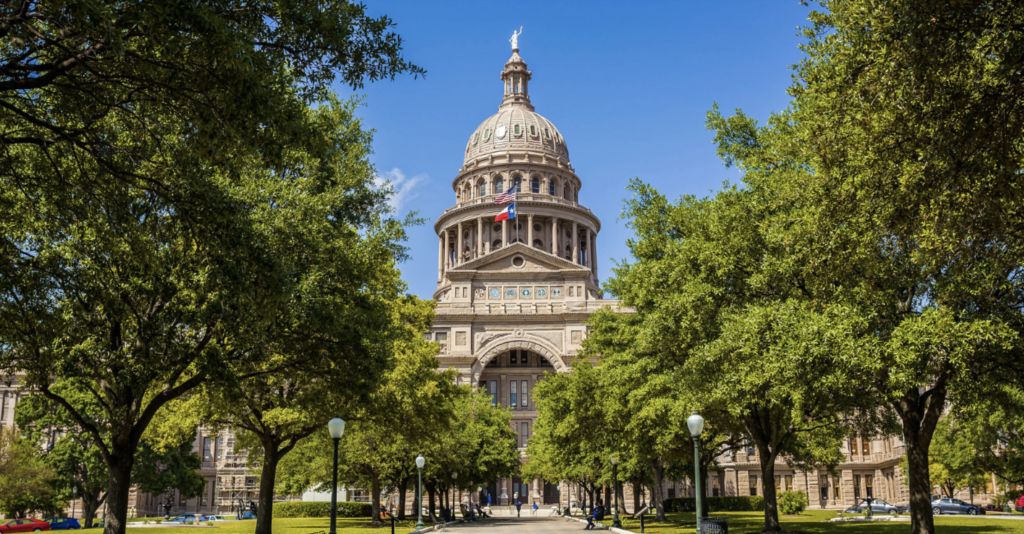
This year’s legislative session highlighted both the progress and the persistent challenges in fulfilling the promise of pre-k — where every child has access to high-quality early learning that prepares them for school and life. Texas lawmakers recognize early learning as key to improving student outcomes, but significant challenges remain in preparing every child for school and ensuring schools are prepared to support young learners’ social and academic development.
Lawmakers expanded access to public pre-k to the children of public school teachers and included children eligible for public pre-k in the new Education Savings Account program. They proposed solutions to address the pre-k funding gap, but ultimately continued to fund pre-k based on a half-day rate. Meanwhile, efforts to extend pre-k eligibility to children with disabilities stalled in the Senate, and policies aimed at supporting pre-k partnerships are raising questions about future funding and oversight. Additionally, the Legislature allowed expanded use of out-of-school suspensions in pre-k through second grade.
In this blog, we’ll break down nine key takeaways for pre-k this session and what the new laws mean for children and families. We will also reflect on what should come next for Texas pre-k to achieve a more cohesive and family-centered early learning system — one that is built to deliver on the promise of pre-k and ensure every family is able to choose the early learning option that works best for them.
1. Lawmakers Recognized the Pre-K Funding Gap
Lawmakers worked toward funding full-day pre-k by changing how the Early Education Allotment is distributed to schools, but they stopped short of correcting the half-day funding formula.
In 2019, the Legislature required public schools to offer a full day of instruction to all four-year-olds whose families choose to enroll. However, funding remained at the half-day level, resulting in pre-k being funded at half the rate of all other grades. This gap has forced school districts to cobble together funding from other sources, including grants, Federal funds like Title I, and local funding they divert from other areas of need.
One such source is the Early Education Allotment (EEA). Created in 2019, the EEA is currently based on low-income and emergent bilingual students’ Average Daily Attendance (ADA) in kindergarten through third grade. In the 2024-2025 school year, the EEA generated approximately $800 million statewide. Districts can use this funding to support pre-k programs or to implement early literacy and numeracy strategies outlined in their Early Childhood Literacy and Mathematics Proficiency Plans.

HB 2, the major school funding bill passed this session, raises the total amount of EEA funds by adding a small weight to all kindergarten through third-grade students in ADA to generate an increase of approximately $90 million. This new funding is in part intended to cover the cost of new requirements for stipends for teachers who complete reading or math academies outside of their regular working hours.
Lawmakers sought to address the pre-k funding gap through HB 2 by changing the way existing money generated by the EEA is distributed to schools. Before HB 2, the $800 million was disbursed to schools based on the kindergarten through third-grade low-income and bilingual students who generated the funds. After HB 2 goes into effect, the funds generated by the EEA will first be distributed to schools in an amount equal to half ADA for eligible 4-year-old pre-k students. Any amount remaining will then be distributed on a pro-rated basis to schools based on the number of students in kindergarten through third grade who are low-income or bilingual.
The specific impact of this change on school districts and pre-k programs remains unclear. Districts with robust pre-k programs may see an increase in EEA funding, while schools with lower pre-k attendance may see a reduction. In recent years, many districts have increasingly relied on the EEA to fund new early literacy requirements in kindergarten through third grade, although their use of the funds is varied. Some districts dedicate all their EEA funds to pre-k, while others may opt to use the funds on reading specialists for kindergarten through third-grade students, among other strategies. Even though the EEA funds under HB 2 will first be distributed based on pre-k ADA, these funds can still be used for early literacy and numeracy strategies in pre-k through 3rd-grade. This flexibility requires school leaders to weigh student needs, state requirements, and available funding sources when determining how to allocate these funds (a dynamic that is consistent with how districts have approached EEA spending prior to HB 2).
Texas should build on the important steps taken this session to better align early education funding with student and family needs. Education leaders should assess whether HB 2’s funding strategies sufficiently close the pre-k funding gap and support high-quality, full-day programs, along with evidence-based early learning from pre-k through third grade. To ensure the policy delivers on its promise, the state should also provide clear guidance on how to implement aligned, high-impact strategies that strengthen early learning outcomes.
In its annual State of Preschool Yearbook, the National Institute for Early Education Research (NIEER) ranked Texas 40th in reported pre-k spending and found that the state meets just 2 out of the 10 quality benchmarks it uses to assess programs. These benchmarks include low-student-to-teacher ratios, early learning standards, and educator qualifications – components that research shows support children’s academic outcomes. Without sufficient investment in both quality and access, Texas risks failing to deliver on the promise of pre-k.
2. Education Savings Accounts for Some Pre-K Students
Education Savings Accounts, funded through SB 2, will allow for some children who are eligible for pre-k to receive financial assistance for private school and child care options.
The Legislature also passed Senate Bill 2, creating an Education Savings Account (ESA) program for students in pre-k through 12th grade. Starting in the 2026-2027 school year, three- or four-year-old children who are eligible for pre-k will be able to complete an application created by the Texas Comptroller to access the ESA dollars. These funds are based on a percentage of per-pupil funding for public school students and are projected to be above $10,000 per student. Students with special needs, including those eligible for pre-k, will be eligible to receive up to $30,000 based on the educational support outlined in their individualized education plan (IEP). However, private schools are not legally required to follow the IEP in the same manner as public schools under the Individuals with Disabilities Education Act (IDEA). Families who homeschool eligible pre-k children can also access up to $2,000.
If parents of a pre-kindergartner receive an ESA, they can use it for certain educational expenses, including enrolling in a private school. The Comptroller will also establish a process for private schools and child care providers to be pre-approved for participation in the program. Private schools must be accredited by the Texas Private School Accreditation Commission (TEPSAC) or an organization recognized by the Texas Education Agency. For the purpose of pre-k and kindergarten, a child care provider can also participate by meeting one of the following qualifications:
- Accredited by a research-based, nationally recognized, and universally accessible accreditation system approved by TEA;
- Be a Texas Rising Star Program provider with a three-star certification or higher;
- Be a Texas School Ready! participant; or
- Have an existing partnership with a school district to provide a pre-k program.
The Education Savings Account program is limited by appropriation set by the Texas Legislature every two years. In the first biennium, that limit is $1 billion. If the applications for the program exceed the funds available, the Comptroller will conduct a lottery that prioritizes children based on four categories.
- The first priority group is students with special needs, including those children with special needs who are eligible for public pre-k based on one of the eight eligibility categories.
- The second priority group will consist of children whose family income is below 200 percent of the Federal Poverty Guidelines (FPG), which is currently $64,300 a year for a family of four. Since most children enrolled in Texas public pre-k qualify based on a family income below 185 percent of the FPG, many of these students would fall in the second priority group to receive an ESA alongside low-income students in kindergarten through 12th grade.
- The third priority group includes students whose family income falls between 200 and 500 percent of the FPG.
- The fourth priority group includes those with a family income above 500 percent of the FPG.
The program also limits the percentage of funds that can be allocated to families with incomes above 500 percent of the FPG to 20 percent of the total funds available. If the cap goes into effect, the Comptroller is required to prioritize students from higher-income families who were previously enrolled in public schools over those students who already attend private schools. The waitlist and prioritization of those on the waitlist could have significant implications for the number of pre-k students who are likely to receive an ESA.
3. Public Pre-K for Children of Public School Teachers
Children of public school teachers are now eligible for free public pre-k in the school districts where they work.
Texas has consistently rated highly in pre-k access, although eligibility remains limited. Before HB 2, eligibility for full-day pre-k for four-year-olds (and some three-year-olds) included the following populations:
- Low income (below 185% of the federal poverty guidelines)
- Homeless
- Emergent Bilingual
- Currently or previously in foster care
- Child of active duty military
- Child of a member of the armed forces killed in action or injured
- Child of a person eligible for the Star of Texas Award
Now, through HB 2, children of public school teachers will be eligible to attend public pre-k for free in the district where their parent works. This benefits children and their families by expanding access to quality early learning, while also strengthening the teacher workforce by supporting efforts to recruit and retain qualified teachers.
4. Lawmakers Worked to Address Pre-K Partnership Challenges
Lawmakers took several steps aimed at reforming pre-k partnerships between public schools and child care providers; however, strategies to provide more funding for these partnerships failed to pass.
 In recent years, lawmakers adopted policies aimed at supporting public-private partnerships for pre-k. Pre-k partnerships are collaborations between school districts and Head Start or private child care providers. In a formal partnership, a child eligible for public pre-k can be enrolled in a private child care center, with public funds passing from the school district to the child care center.
In recent years, lawmakers adopted policies aimed at supporting public-private partnerships for pre-k. Pre-k partnerships are collaborations between school districts and Head Start or private child care providers. In a formal partnership, a child eligible for public pre-k can be enrolled in a private child care center, with public funds passing from the school district to the child care center.
Strong partnerships between school districts, child care providers, Head Start programs, and community organizations may offer several benefits to pre-k programs and families. These partnerships can provide an opportunity to share resources and coordinate services, ensuring that children receive consistent, high-quality early learning experiences, whether at a school or a private child care center. Additionally, by working together, partners can address local community needs more effectively, fill gaps in care, and provide more comprehensive early learning support to families.
HB 2 changes policies related to these pre-k partnerships in several ways:
- The legislation streamlines local regulations for schools and child care centers to facilitate pre-k partnerships.
- A minimum of 85 percent of the funds a pre-k student is entitled to under the school finance system must be passed through to the private provider serving that student in a pre-k partnership, although districts may apply for waivers.
- The Texas Education Agency must designate at least four intermediary entities to support the development and oversight of pre-k partnerships.
- The state’s annual early education reports must now include data on the number of students served through pre-k partnerships.
Before the final version passed, lawmakers also removed several positive provisions related to pre-k partnerships that passed the House. The final version of HB 2:
- Does not ensure full-day ADA funding for children enrolled in pre-k partnerships.
- Does not allow children receiving child care scholarships to be automatically eligible to enroll in public pre-k in a partnership classroom.
Despite the potential benefits of pre-k partnerships, they remain limited across the state, with community members citing regulatory and logistical challenges. While HB 2 begins to address some of these challenges, it does not go far enough to address the root cause of many of the barriers to pre-k partnerships, including distinct standards and student eligibility qualifications between schools and subsidized child care programs. For example, public schools might have requirements that conflict with child care licensing requirements. Additionally, there is no clear guidance on how those implementing partnerships should navigate these conflicts and align requirements from multiple funding streams.
The pre-k funding gap has also created challenges in scaling and sustaining pre-k partnerships, with districts passing through a percentage of half-day funds to child care providers. The 85 percent required passthrough may increase the funds received by child care providers, though it would have been more impactful if paired with full ADA funding for those enrolled in partnerships. Additionally, there are concerns that mandating a certain percentage of funds to be passed from the school district to the child care provider may not account for varied local needs. For instance, some school districts might provide more support for assessments, data collection, and attendance, or offer more instructional support for special education and bilingual students. In these cases, it may be beneficial for districts to retain funds in exchange for these additional services. The bill allows the Texas Education Agency commissioner to waive this requirement upon the request of a school district.
5. Public Schools Face New Barriers to Maintain and Expand Pre-K
School districts must receive a determination that no eligible private child care is available to engage in a pre-k partnership before the district repurposes, builds, or leases a classroom to serve pre-k students.
HB 2 includes a new requirement for school districts to receive verification from a designated intermediary that no child care provider is available before the school can build or repurpose a classroom for eligible pre-k students. While intended to prioritize partnerships, this added barrier could have unintended consequences for districts, particularly fast growth districts, from meeting the demand for high-quality pre-k.
If schools are unable to build or repurpose classrooms for pre-k, they may face larger class sizes and higher student-to-teacher ratios — potentially making programs less effective. These challenges underscore the need to reevaluate the impact of these policies and provide clear guidance and support as school districts navigate these new requirements.
6. New Threats to Tuition-Based Pre-K Options
New rules may limit access to pre-k in public schools for those outside state eligibility categories — making it harder for families to find options that work for them.
HB 2 creates new barriers for school districts to offer tuition-based pre-k, without ensuring families have an affordable alternative. Currently, school districts may offer tuition-based pre-k if there is space available to families who are outside of the eligible populations for free pre-k. While it does come with a cost to parents, tuition-based pre-k through public schools is generally more affordable than private preschool or child care programs. Only a small percentage of the state’s pre-k is children enrolled in tuition-based programs. Approximately 10,000 families choose this option, which offers an affordable way to provide their children a safe and supportive early learning environment.
Districts may continue to offer tuition-based pre-k during the 2025-2026 and 2026-2027 school years. However, the new requirement, which goes into effect for the 2027-2028 school year, may impact how and whether tuition-based pre-k can be provided. After the new provision goes into effect, districts may only offer tuition-based pre-k if one of the four designated intermediary organizations confirms that no eligible private provider is available to serve the student. The Texas Education Agency will establish rules to define what constitutes availability. This could result in fewer quality options for families, not more. For example, while classroom teachers are now eligible for free pre-k, other school staff — such as those working in the front office, cafeteria, or library — may not qualify, yet would benefit from having access to an affordable, tuition-based option at the school where they work.
7. Pre-K Eligibility for Children with Disabilities Passed the House but was Removed in the Senate
Children with disabilities are still not eligible for public school pre-k, unless they meet one of the other eligible categories.
The House version of HB 2 extended pre-k eligibility to students with disabilities, but that provision did not pass the Senate. This would have ensured greater access to high-quality early learning and targeted interventions during a pivotal developmental window. For example, a student with a language delay would benefit from both one-on-one interventions with a speech-language pathologist and talking with other students in a high-quality pre-k classroom.
Although it does not immediately address the need to ensure children with disabilities are eligible for pre-k, lawmakers did pass HB 2310, which directs the Texas Education Agency to study how to better serve children with disabilities during early childhood. The strategic plan will identify barriers to early education and assess the availability of high-quality settings that can meet their needs while learning alongside their non-disabled peers. This is a critical step toward ensuring all children receive effective early instruction and intervention. Moving forward, it will be essential for the state to engage families, educators, and advocates in shaping policies that improve the capacity of early learning programs to meet the needs of children with disabilities.
8. Lawmakers Invested in Child Care, Including for 3- and 4-year-olds
A $100 million investment in child care scholarships will support affordable early learning options for preschoolers, as well as infants, toddlers, and school-age children.
Lawmakers approved an additional $100 million investment in child care scholarships, enabling thousands more families to access high-quality early learning. This new funding can help families access early learning for their three- and four-year-old children, as well as infants, toddlers, and school-age children, making high-quality learning, regardless of setting, more accessible. While these funds are not explicitly dedicated to school-based pre-k opportunities, they do provide thousands more families with access to high-quality early learning programs prior to kindergarten that can support school readiness. Furthermore, as pre-k partnerships between child care programs and school districts rely upon blending and braiding public school funding and child care scholarship funding, these funds could support more opportunities for partnerships moving forward.
9. Out-of-School Suspensions for Pre-K Students Were Expanded
Lawmakers passed a sweeping school discipline bill that expanded circumstances where out-of-school suspensions are allowed, potentially leading to four- and five-year-olds being removed for common behaviors for their age and missing essential foundational learning.
The school discipline bill passed by the Legislature, House Bill 6, adds “repeated or significant disruption” to the allowable circumstances in which Texas’s youngest learners — including students in pre-k, kindergarten, 1st grade, and 2nd grade — may be subject to out-of-school suspensions. The provision rolls back some of the important limits the Legislature placed on pre-k — 2nd grade suspensions in 2017. Prior to the passage of HB 6, the law already allowed for out-of-school suspensions for students in pre-k through second grade in cases of violent behavior and other serious circumstances, as well as in-school suspension. The addition of disruption is likely to result in more young children being removed from school during a critical period of their development, without providing children or their teachers with support to improve their behavior when they return to school.
 In 2018, Texans Care for Children released a report that outlined why out-of-school suspensions are ineffective for young learners, how state policy contributes to early childhood suspensions, and what strategies should be adopted at the state and local levels to support students’ behavior. The report examined statewide and district-level data that showed districts with high rates of pre-k suspensions and that certain student groups, like those in foster care or in special education, were more likely to be suspended.
In 2018, Texans Care for Children released a report that outlined why out-of-school suspensions are ineffective for young learners, how state policy contributes to early childhood suspensions, and what strategies should be adopted at the state and local levels to support students’ behavior. The report examined statewide and district-level data that showed districts with high rates of pre-k suspensions and that certain student groups, like those in foster care or in special education, were more likely to be suspended.
The new law allows parents to submit a written request for a student placed in out-of-school suspension to be reassigned to an in-school suspension if the parent is unable to stay home with the child or find suitable child care. However, the decision to grant the request is at the sole discretion of the school administrators. Despite these changes, school leaders should continue to implement best practices in the classroom to support students’ social and academic outcomes. At the state level, education leaders should address barriers to supportive classroom environments — such as high student-to-teacher ratios, inadequate support for teachers, and insufficient nutrition, rest, and play — by promoting age-appropriate schedules and ensuring adequate staffing and resources.
What’s Next for Pre-K in Texas?
While the passage of HB 2 represents a significant investment in education, it also leaves critical questions about the future of pre-k in Texas unanswered. How will changes to the EEA distribution impact school districts across the state, and will it lead to more spending on pre-k quality? Will the policies adopted support emergent bilingual students, who make up 37 percent of the state’s pre-k enrollment, or are more targeted strategies needed? Is Texas on track to serve more families in quality pre-k? Will new policies related to pre-k partnerships increase partnerships, introduce new challenges, or both? And how will districts — and the intermediary organizations overseeing partnerships — navigate new requirements for opening pre-k classrooms and assessing the availability of child care in the community? There are also questions about how SB 2 will affect families’ access to private pre-k options, both in the short and long term.
At the same time, lawmakers advanced a set of bills that lay the groundwork for important conversations this interim. HB 117 establishes a task force on early childhood governance, HB 3963 creates an integrated data system, and HB 4903 launches a quad-agency effort to streamline child care regulations. Together, these measures provide an opportunity to answer critical questions, hear from Texas families about their needs, better understand the funding gaps in both pre-k and child care settings, and build a more effective early learning system to meet the needs of Texas families.
As these efforts move forward, it will be essential to center the voices of parents and caregivers. Parents know their child best and offer critical insights on what is and is not working for their families’ everyday needs. These insights can help shape policies that are more responsive to families’ real-world experiences of navigating our early learning systems. Elevating these voices will be especially important in the months ahead, as the focus shifts to how the laws passed this session impact children and families.
During the interim, we will closely track the implementation of the legislation passed this session and its implications for young learners. The work doesn’t stop here — now is the time to continue engaging with state and local leaders, as well as families, to ensure these policy changes truly meet the needs of Texas children and their families. Better data and ongoing evaluation will be more important than ever to understand the impact of these policies on Texas children and their families. Moving forward, the work must focus on ensuring both ready students and ready schools – where children arrive equipped to learn, and schools are prepared to meet their needs.
Ensuring families have access to high-quality early learning options that meet their needs will require policy leaders to champion strategic investments in both pre-k and child care. At Texans Care for Children, we will continue to collaborate with partners, lawmakers, and communities across the state to help shape the next phase of progress for Texas pre-k – ensuring every child has access to high-quality early learning that enables them to thrive in school and life.



